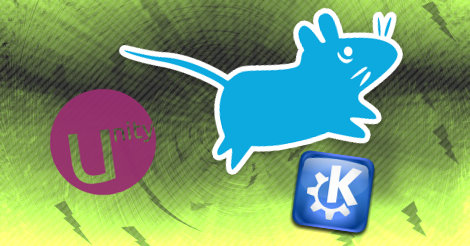How to Install a Different Desktop Environment in Ubuntu
Tutorial showing how to install a desktop like KDE or Cinnamon in Ubuntu.

By. Jacob
Edited: 2019-09-24 16:36

To install a different desktop environment in Ubuntu, you would simply open up a Terminal, and install it via the apt-get install whatever-desktop-environment command. Sometimes you may encounter problems, but they should generally be easy to fix, and there is plenty of help available online.
If you wish to try a GNOME session, you can simply logout, and choose the "GNOME Classic" option when logging in.
Rather than just installing from the terminal, it may be a good idea to install from a console instead, as it may avoid some problems. You can press or CTRL + ALT + F2 to exit to a console, then enter the following command to exit your current x session).
sudo stop lightdm
Install the KDE desktop
If you wish to install the KDE desktop environment in Ubuntu, you would simply run the below command in a terminal window or console:
sudo apt-get install kubuntu-desktop
You should pay attention to any problems doing the installation. A fairly common problem seem to involve a conflict with packages, causing unmet dependencies. Running the following commands may solve the problem:
sudo dpkg -P unity-scope-gdrive account-plugin-google
sudo apt-get -f install
Another problem is that the Ubuntu boot splash will be replaced with the kubuntu logo. This is purely visual, but if you want to change back to the Ubuntu logo, running the below command will allow you to choose between available splash screens:
sudo update-alternatives --config default.plymouth
Install the Cinnamon desktop
Cinnamon can be installed by first adding the repository, then running your standard apt-get install package. Both can be accomplished with the following commands:
sudo add-apt-repository ppa:embrosyn/cinnamon
sudo apt-get update && sudo apt-get install cinnamon
If you wish to later remove Cinnamon, run:
sudo ppa-purge ppa:embrosyn/cinnamon
Install the XFCE desktop
You may install XFCE in Ubuntu via this command:
sudo apt-get install xubuntu-desktop
Install the Gnome desktop
The gnome desktop can be installed with:
sudo apt-get install ubuntu-gnome-desktop
If you encounter any problems, such as overlapping icons in overview, you can try switching to GDM display manager instead of lightdm. You can install GDM via apt-get:
sudo apt-get install gdm
Troubleshooting
Problems with changing display manager (I.e. From lightdm to GDM) might cause you to get stuck on the loading splash screen doing boot. To fix this, you may need to hit CTRL + ALT + F1, and then reinstall your desktop environment – don't worry, this should not effect your personal files.
If for example you installed the Gnome desktop, an easy way to fix certain problems is to simply re-install it after removing it properly. To do this, run something like the following:
- sudo apt-get remove ubuntu-gnome-desktop
- sudo apt-get remove lightdm
- sudo apt-get autoremove
- sudo apt-get install ubuntu-gnome-desktop
The GDM display manager should be automatically installed, and you will be prompted to choose a display manager. While others should also work, GDM might work better with Gnome. You just have to test, and see which you like better.
After installing another desktop, you might also encounter minor problems with your Themes. To fix those, you can open up the Gnome-tweak-tool, choose the default theme for your desktop, (In Gnome: Adwaita). Typical problems are rounded corners having black backgrounds, and missing GUI controls (the GUI controls are not missing, just the icons.)
Alternatively, you can check for updated versions of your Themes, or you can try and fix the themes yourself. Some settings can be changed with simple CSS declarations.

Tell us what you think:
There are also versions of Ubuntu with just those desktops
Kubuntu, Xubuntu and Lubuntu